A Glimpse Into Salamander Diversity
By Amy Nelson
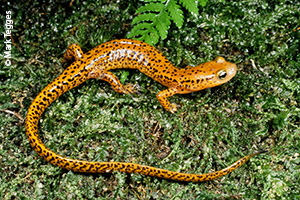
There are, as of today, 675 species of salamanders in the world, and their diversity is dazzling. From brightly colored and patterned to pigmentless, they range in size from little over an inch to five feet in length. Some are aquatic, some use water only for breeding, and some are entirely terrestrial.
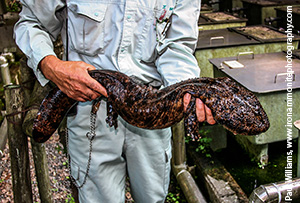
To gain just a glimpse into the incredible biodiversity of salamanders, we highlight two species from three different types of home ranges: rivers, caves, and forests near vernal pools for breeding. The species featured also represent four of the ten families that exist within the order Caudata.
We were able to get up close and personal with a few of these species by visiting the National Aquarium in Baltimore and the Maryland Zoo. Admittedly, salamanders don’t make the greatest exhibit subjects due their secretive, nocturnal nature, but they are occasionally featured in special exhibits, and they are frequently used in outreach and education programming.
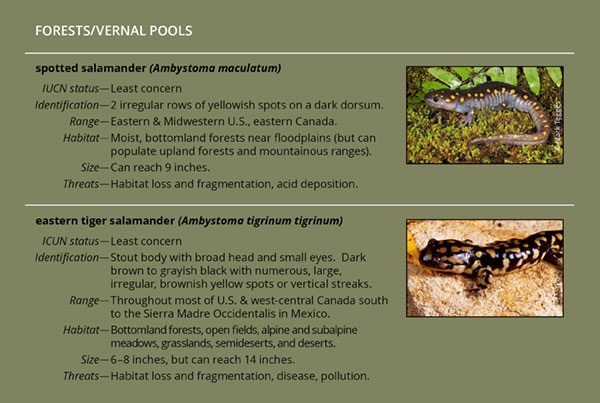
Take a walk through just about any bottomland forest in the eastern U.S., and you’re likely to find spotted (Ambystoma maculatum) and eastern tiger (Ambystoma tigrinum tigrinum) salamanders. If you know how to look for them, that is.

Like other members of the Ambystomatidae, or “mole salamander” family, both species live most of the year under rocks, in the leaf litter, underground, and generally out of sight. The eastern tiger salamander may burrow as deep as two feet into the soil. Vertical channels, called “costal grooves,’ line both salamanders’ bodies, and help distribute moisture to their skin. They emerge from their hiding spots only at night to feed, and during spring mating season. And oh, what a season it is.
When warming temperatures combine with precipitation to produce what herpetologists call the “salamander rains,” quite a spectacle ensues as they mass migrate to breeding spots. Spotted salamanders breed in any fish-free, ephemeral habitat, such as a vernal pool, ditch, or even flooded tire track. Eastern tigers are a bit less selective, and may also breed in permanent habitats like farm ponds or subalpine lakes. In Maryland, the salamander rains can occur between January and March, and if you’re fortunate enough to be near a breeding site when it happens, you are in for quite a spectacle.
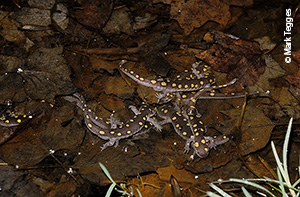
“It’s a nuptial dance,” says Jack Cover, general curator and salamander aficionado at the National Aquarium. Unlike male frogs, who use sound to attract mates to many of the same breeding spots, the salamanders communicate via chemicals. The male salamander uses different types of pheromones and secretions to lure females. Upon encountering a female, the male begins an elaborate dance which can involve head swinging, circling the female and nudging her with his snout, rubbing his head under hers to release pheromones, and even a bit of shuffling. According to Cover, the ponds become so alive with this nuptial dance that “it almost looks like the water is boiling with salamanders,” said Cover.

The dance concludes with the male depositing a packet of sperm called a spermatophore on the substrate. When a female finds a spermatophore, she inserts it into her cloaca. The eggs are then fertilized internally. The female tiger salamander will deposit eggs individually or, more typically, in small clusters on a submerged branch. The female spotted salamander will deposit her eggs in larger clusters, either on branches, aquatic vegetation, or the pond bottom. In both cases, eggs appear as a gelatinous cluster. The larvae then develop and hatch into aquatic larvae, which have feather-like, external gills. They eat a wide variety of small aquatic insects, zooplankton, and other salamander larvae.
It is not exactly known how spotted and eastern tiger salamanders navigate to their breeding spots year after year. Though populations primarily return to the same pond, there is some gene flow between nearby ponds, and that creates metapopulations. “You have a hillside habitat where the salamanders live for most of the year and then a vernal pool where they breed,” says Cover. “But what happens when someone puts a road, with heavy traffic, in between that hillside and the vernal pool? End of story for those salamanders.”
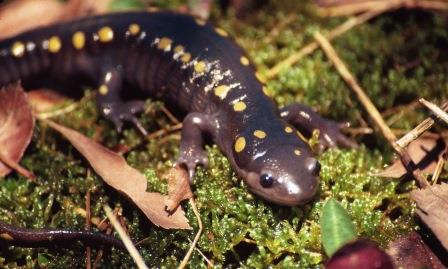
Indeed, habitat loss and fragmentation is the main threat to spotted and eastern tiger salamanders. Other threats include decreased pH levels in breeding pools due to increased acid deposition from weather patterns or road salting,
“If everyone could get into the field to witness the mole salamanders’ annual nuptial dance,” said Cover, “they would understand how important that little, seemingly insignificant patch of wetlands is for the whole surrounding area. It’s like a vital organ. “

Knowing that not everyone can witness the annual pulse of amphibian breeding, Cover and the staff at the National Aquarium maximize the use of salamanders in outreach activities. “People have become so removed from nature,” says Cover. “What we try to do at the Aquarium is reconnect them.” They often bring them to special events and feature them in temporary displays where, according to Cover, they tend to stimulate lots of conversation.
It is those conversations, particularly with children, that give Cover hope for salamanders and other amphibians. “Just last night, I was at an event, and I asked a child if he knew the difference between a salamander and a lizard,” he said. “The parents sat there dumbfounded as their kid explained that salamanders are amphibians, while lizards are reptiles, and that lizards, unlike salamanders, have scales and claws, and lay shelled eggs.“
Cover’s passion for the spotted and eastern tiger salamanders—and for all salamanders in the U.S.—is palpable and infectious.
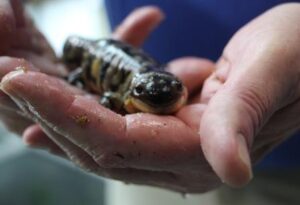
“Some people have the notion that all the cool animals are in the tropics. But the U.S. has some of the greatest salamander diversity of the world! We should have national pride in our salamander fauna!”
Given their accessibility, abundance, and ability to charm even a hardened Leaf Litter editor on deadline, the spotted and eastern tiger salamander would make ideal ambassadors.
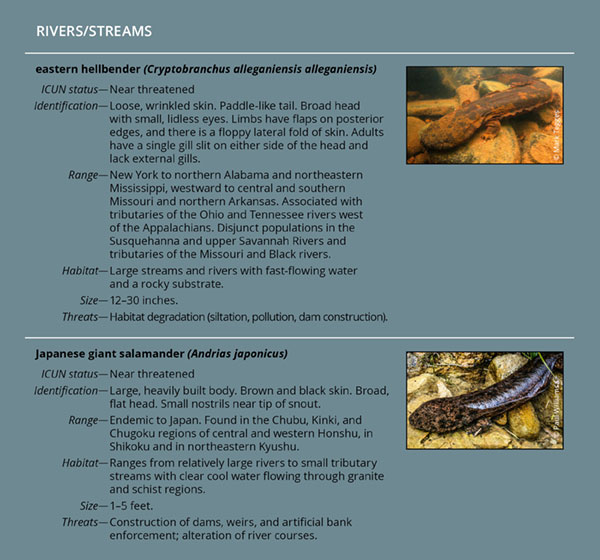
Though they live on different continents in different hemispheres, the Japanese giant salamander (Andrias japonicas) and the eastern hellbender (Cryptobranchus alleganiensis alleganiensis) have quite a lot in common.

Both are members of the Cryptobranchidae family of salamanders. Salamanders of this suction-feeding, aquatic, nocturnal family are known for their remarkable size. The Japanese giant salamander is the second largest salamander in the world (behind the Chinese giant salamander), measuring up to five feet in length and weighing up to 75 lbs. Though the eastern hellbender (and its close relative, the Ozark hellbender) is about half the size of the Japanese giant salamander, hellbenders are the largest salamander species in North America.
Both Japanese giant salamanders and eastern hellbenders are highly adapted to their aquatic environments. Their short legs, flattened bodies, and laterally compressed, finlike tails enable them to move easily in streams and rivers. Both species breed in late summer, and exhibit a strong paternal instinct. Males excavate saucer-shaped “nests” beneath rocks or in logs. The female lays eggs in the nest, and they then are fertilized by the male. Male hellbenders and Japanese giant salamanders guard their nests rigorously, keeping watch over the eggs until they hatch.
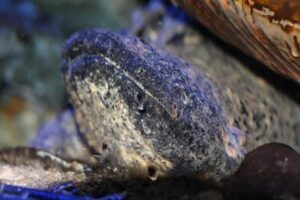
The two species share something else: a reputation for being ugly. Loose folds of fleshy skin and a thick coating of slime cover the bodies of both the eastern hellbender and the Japanese giant salamander. Both have small, lidless, beady eyes. The eastern hellbender has nicknames like “snot otter” and “devil dog.” The Maryland Department of Natural Resources describes it as “having a face only a mother or a herpetologist could love.”

Ugly or not, the eastern hellbender and the Japanese giant salamander are incredibly unique animals—and they are both in trouble. Both species breathe almost entirely through their skin, so cold, clean, well-oxygenated, flowing water is critical to their survival. With habitat degradation caused by impoundments, pollution, and siltation, hellbenders are now threatened or endangered in many states where they once thrived. Though no longer hunted for food or medicinal purposes, the Japanese giant salamander, which has been fully protected by Japanese law since 1952, is threatened by the construction of dams and artificial banks, which greatly inhibit spawning.

As with other salamanders, the ecological roles of the eastern hellbender and Japanese giant salamanders are still being studied. “We’re still learning what role they play,” says the National Aquarium’s Jack Cover of eastern hellbenders. “They may play a bigger role in stream ecology than we know. The role that forests play in freshwater stream health is now clear. When forests in the watersheds of hellbender streams are cleared, resulting siltation and polluted stormwater runoff is the beginning of the end of those populations. Hellbenders are great bio-indicators. Healthy hellbender populations mean healthy streams and healthy forests. The forests are a key component of their life support system and our life support system.”
Fortunately, many conservation and outreach efforts have been underway for both of these members of the Cryptobranchidae family. Not surprisingly, many of them have involved zoos and aquariums.
In Japan, there have been efforts to conserve and rebuild spawning habitat along the Ichi River. A program in Kyoto is helping giant salamanders get past dams built to control flooding so the rare amphibians can lay their eggs upstream (see this video). The City of Hiroshima Asa Zoological Park, one of few zoos in Japan to have successfully bred Japanese giant salamanders, is currently raising a third generation. In December of 2009, they presented four Japanese giant Salamanders to the Smithsonian National Zoological Park (National Zoo) in Washington, DC.
The National Zoo, which was instrumental in describing the lethal chytrid fungus (the cause of Chytridiomycosis, an emerging disease that has devastated amphibian populations in many parts of the world ) in 1999, is an important player in amphibian conservation. The Japanese giant salamanders are not only on display, but in use by Zoo geneticists to study Bd. The National Zoo is also involved in a number of initiatives aimed at conserving the unique biodiversity of Appalachian salamanders, among them the eastern hellbender.

An hour north of the National Zoo, at the The Maryland Zoo in Baltimore, visitors have a unique opportunity to get up close and personal with the eastern hellbender. The Zoo’s hellbender exhibit, which opened in 2009, was modeled on actual hellbender habitat in Pennsylvania.
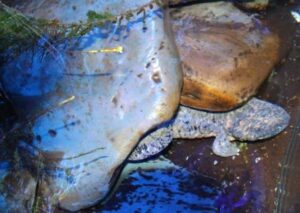
Carefully crafted to ensure the hellbenders could be visible to the public but also comfortable, the exhibit includes numerous hiding areas in the nooks of artificial rocks made from casts of real rock. The two adult hellbenders in the exhibit came from the St. Louis Zoo, a leader in hellbender conservation and the first zoo to breed the animals in captivity.

The Maryland Zoo also has five juvenile eastern hellbenders in a temporary holding tank which came from the Buffalo Zoo, another leading zoo in terms of hellbender conservation. Through the Buffalo Zoo’s head-start project, hellbender eggs are collected from the wild, hatched, raised to a size at which they are likely to survive predation, and re-released in the Allegheny River system.
So what do visitors to the The Maryland Zoo think of the eastern hellbender?
“The hellbender is a hidden gem,” says the Zoo’s Reptile/Amphibian Conservation and Collection Manager, Kevin Barrett. “It lives in Maryland, but I’d guess that ninety-nine percent of our visitors have never seen one until they come here.”
Given the realistic appearance and dark lighting of the exhibit, and the hellbender’s elusive nature and natural camouflage, a visitor’s first glimpse of the hidden gem can require a bit of patience. But it comes with a quite a payoff.

According to Kyle Baumgartner, Area Manager for the Maryland Wilderness section of the zoo, the “Where’s Waldo” thrill of finding something seemingly hidden, combined with the startling, prehistoric appearance of the eastern hellbender makes a lasting impression. “Kids are blown away by it,” he said.
“That moment is what I enjoy the most,” said Barrett, “When that little kid looks and looks for the animal, suddenly sees it, and says ‘Oh my gosh! That’s so cool!’”
According to Baumgartner, giving people a chance to see a threatened or endangered creature that is native and local greatly facilitates a visitor’s jump from learning about a species to caring about its conservation.

“You can talk about elephant conservation all day long, and that is important, but elephants are thousands of miles away from here,” said Baumgartner. “The eastern hellbender is in Maryland’s backyard. If something is killing this animal in the stream you might be fishing or swimming in, what is that going to do to you? If agricultural runoff and other pollutants are causing them problems, what are they doing to us?”
Once that connection is made, said Baumgartner, visitors begin to understand that they can take small steps, such as stopping erosion in their neighborhood streams, which can have a positive impact downstream. But experts agree that for both the eastern hellbender and Japanese giant salamander, a great deal of habitat protection and improvement is needed.
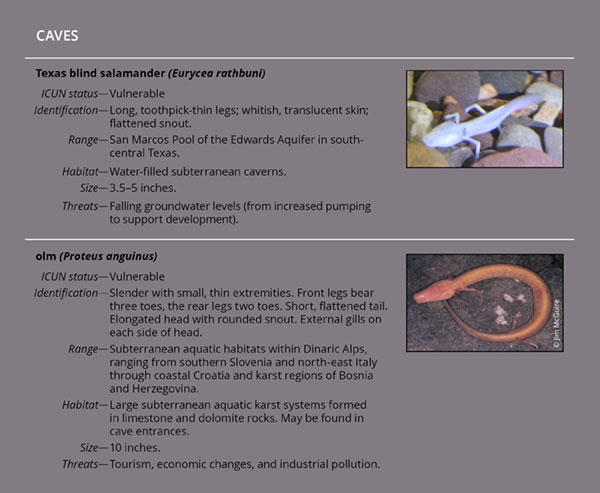
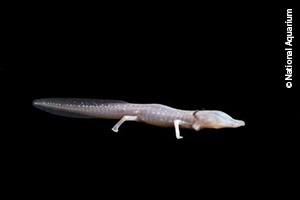
Imagine living in a dark cave, underwater, with only your non-visual senses to guide you toward food or shelter. Now you know what it’s like to be a Texas blind salamander (Eurycea rathbuni) or an olm (Proteus anguinus).
Frail, slender, and virtually pigmentless, the Texas blind salamander lives in the underground water system of the limestone caverns of the Edwards Aquifer near San Marcos, Texas.
The olm, also slender, but two to three times the length of the Texas blind salamander, is found in underwater caves in Slovenia, Croatia, Bosnia and Herzegovina, and Italy.
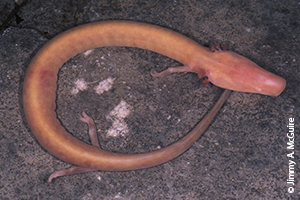
Though they belong to different families—the olm is a member of the Proteidae family and the Texas blind salamander is a member of the Plethodontidae (lungless salamander) family—they share many characteristics, including a strong dependence on the stability and purity of their subterranean habitats.
Both the Texas blind salamander and the olm are completely aquatic, and both have skin so translucent their internal organs are visible. Little is known about how either species breeds and reproduces. Both creatures live in total darkness, so they have no need for vision, and rely on their acute sensory systems to find food (mainly subterranean invertebrates). The Texas Blind salamander is thought to rely primarily on smell and vibration.
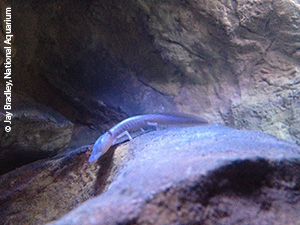
“With its little matchstick legs, and no pigment, it looks like this poor, skinny, little guy,” said Cover, who is able to observe the Texas blind salamanders currently on exhibit at the National Aquarium. “There’s not much food [in its habitat] but it eeks out a living. Once in a while, it’ll feed on some kind of aquatic arthropod that was nourished by bat guano.”

The olm actually uses chemoreceptors, mechanoreceptors, and electroreceptors. Both species live in a low-energy environment. Perhaps that is why the olm can survive without food for up to 10 years. The olm clearly is doing something right. It is thought to be the longest-lived amphibian, living an average of 69 years. According to studies conducted by the University of Lyon, olms also show no sign of age-related physical decline.
Despite its impressive lifespan, the olm, like the Texas blind salamander, is incredibly sensitive to environmental change. For the Texas blind salamander, whose habitat is located between the cities of Austin and San Antonio, threats are directly attributable to burgeoning development, which not only leads to pollution of runoff and groundwater, but reduces groundwater levels. Though the olm is considered a national treasure by the government of Slovenia, and even appears on one of its coins, and though much of its Slovenian range lies within proposed national or international protected areas, population declines are well documented, with tourism, economic changes, and industrial pollution all posing threats.

We were able to get up close and personal with a few of these species by visiting the National Aquarium in Baltimore and the Maryland Zoo. Admittedly, salamanders don’t make the greatest exhibit subjects due their secretive, nocturnal nature, but they are occasionally featured in special exhibits, and they are frequently used in outreach and education programming.
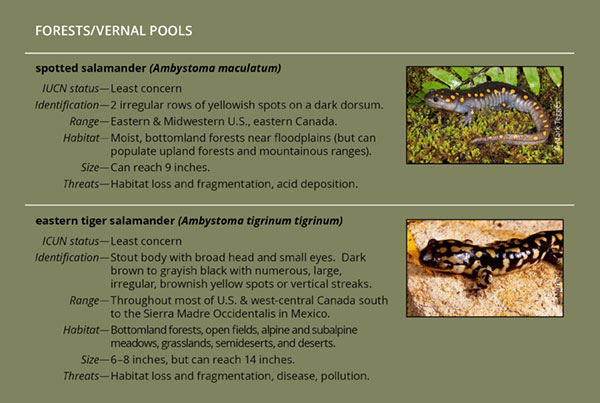
Take a walk through just about any bottomland forest in the eastern U.S., and you’re likely to find spotted (Ambystoma maculatum) and eastern tiger (Ambystoma tigrinum tigrinum) salamanders. If you know how to look for them, that is.

Like other members of the Ambystomatidae, or “mole salamander” family, both species live most of the year under rocks, in the leaf litter, underground, and generally out of sight. The eastern tiger salamander may burrow as deep as two feet into the soil. Vertical channels, called “costal grooves,’ line both salamanders’ bodies, and help distribute moisture to their skin. They emerge from their hiding spots only at night to feed, and during spring mating season. And oh, what a season it is.
When warming temperatures combine with precipitation to produce what herpetologists call the “salamander rains,” quite a spectacle ensues as they mass migrate to breeding spots. Spotted salamanders breed in any fish-free, ephemeral habitat, such as a vernal pool, ditch, or even flooded tire track. Eastern tigers are a bit less selective, and may also breed in permanent habitats like farm ponds or subalpine lakes. In Maryland, the salamander rains can occur between January and March, and if you’re fortunate enough to be near a breeding site when it happens, you are in for quite a spectacle.
“It’s a nuptial dance,” says Jack Cover, general curator and salamander aficionado at the National Aquarium. Unlike male frogs, who use sound to attract mates to many of the same breeding spots, the salamanders communicate via chemicals. The male salamander uses different types of pheromones and secretions to lure females. Upon encountering a female, the male begins an elaborate dance which can involve head swinging, circling the female and nudging her with his snout, rubbing his head under hers to release pheromones, and even a bit of shuffling. According to Cover, the ponds become so alive with this nuptial dance that “it almost looks like the water is boiling with salamanders,” said Cover.
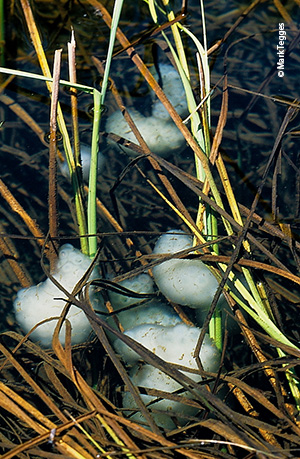
The dance concludes with the male depositing a packet of sperm called a spermatophore on the substrate. When a female finds a spermatophore, she inserts it into her cloaca. The eggs are then fertilized internally. The female tiger salamander will deposit eggs individually or, more typically, in small clusters on a submerged branch. The female spotted salamander will deposit her eggs in larger clusters, either on branches, aquatic vegetation, or the pond bottom. In both cases, eggs appear as a gelatinous cluster. The larvae then develop and hatch into aquatic larvae, which have feather-like, external gills. They eat a wide variety of small aquatic insects, zooplankton, and other salamander larvae.
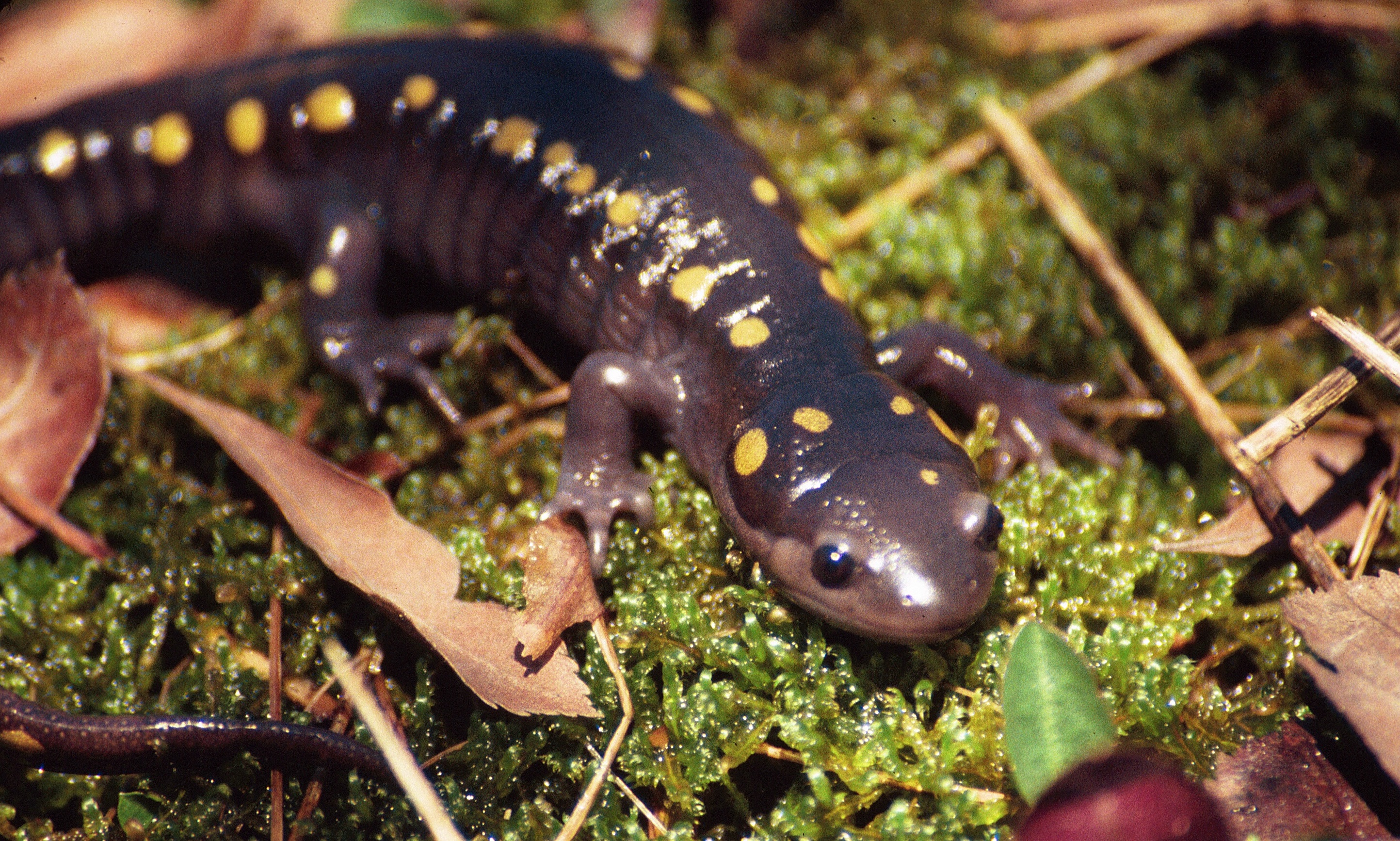
It is not exactly known how spotted and eastern tiger salamanders navigate to their breeding spots year after year. Though populations primarily return to the same pond, there is some gene flow between nearby ponds, and that creates metapopulations. “You have a hillside habitat where the salamanders live for most of the year and then a vernal pool where they breed,” says Cover. “But what happens when someone puts a road, with heavy traffic, in between that hillside and the vernal pool? End of story for those salamanders.”
Indeed, habitat loss and fragmentation is the main threat to spotted and eastern tiger salamanders. Other threats include decreased pH levels in breeding pools due to increased acid deposition from weather patterns or road salting.
“If everyone could get into the field to witness the mole salamanders’ annual nuptial dance,” said Cover, “they would understand how important that little, seemingly insignificant patch of wetlands is for the whole surrounding area. It’s like a vital organ.”

Knowing that not everyone can witness the annual pulse of amphibian breeding, Cover and the staff at the National Aquarium maximize the use of salamanders in outreach activities. “People have become so removed from nature,” says Cover. “What we try to do at the Aquarium is reconnect them.” They often bring them to special events and feature them in temporary displays where, according to Cover, they tend to stimulate lots of conversation.
It is those conversations, particularly with children, that give Cover hope for salamanders and other amphibians. “Just last night, I was at an event, and I asked a child if he knew the difference between a salamander and a lizard,” he said. “The parents sat there dumbfounded as their kid explained that salamanders are amphibians, while lizards are reptiles, and that lizards, unlike salamanders, have scales and claws, and lay shelled eggs.“
Cover’s passion for the spotted and eastern tiger salamanders—and for all salamanders in the U.S.—is palpable and infectious.
“Some people have the notion that all the cool animals are in the tropics. But the U.S. has some of the greatest salamander diversity of the world! We should have national pride in our salamander fauna!”
Given their accessibility, abundance, and ability to charm even a hardened Leaf Litter editor on deadline, the spotted and eastern tiger salamander would make ideal ambassadors.
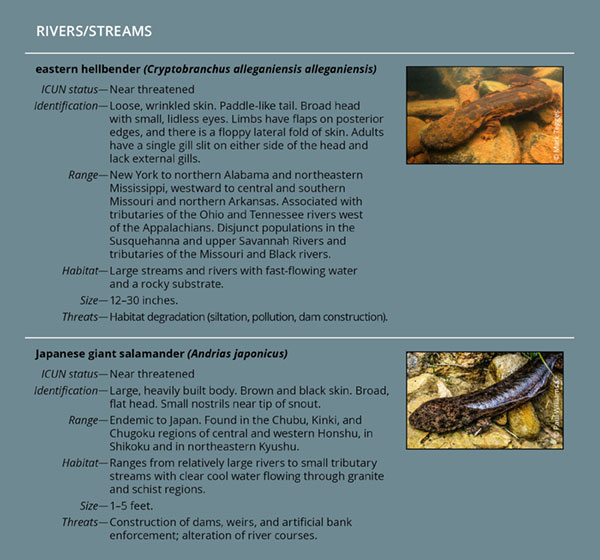
Though they live on different continents in different hemispheres, the Japanese giant salamander (Andrias japonicas) and the eastern hellbender (Cryptobranchus alleganiensis alleganiensis) have quite a lot in common.
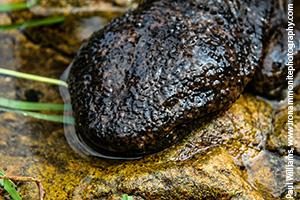
Both are members of the Cryptobranchidaefamily of salamanders. Salamanders of this suction-feeding, aquatic, nocturnal family are known for their remarkable size. The Japanese giant salamander is the second largest salamander in the world (behind the Chinese giant salamander), measuring up to five feet in length and weighing up to 75 lbs. Though the eastern hellbender (and its close relative, the Ozark hellbender) is about half the size of the Japanese giant salamander, hellbenders are the largest salamander species in North America.
Both Japanese giant salamanders and eastern hellbenders are highly adapted to their aquatic environments. Their short legs, flattened bodies, and laterally compressed, finlike tails enable them to move easily in streams and rivers. Both species breed in late summer, and exhibit a strong paternal instinct. Males excavate saucer-shaped “nests” beneath rocks or in logs. The female lays eggs in the nest, and they then are fertilized by the male. Male hellbenders and Japanese giant salamanders guard their nests rigorously, keeping watch over the eggs until they hatch.
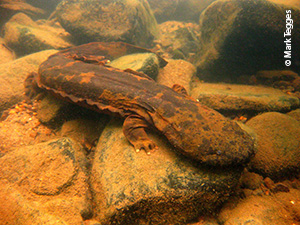
The two species share something else: a reputation for being ugly. Loose folds of fleshy skin and a thick coating of slime cover the bodies of both the eastern hellbender and the Japanese giant salamander. Both have small, lidless, beady eyes. The eastern hellbender has nicknames like “snot otter” and “devil dog.” The Maryland Department of Natural Resourcesdescribes it as “having a face only a mother or a herpetologist could love.”
Ugly or not, the eastern hellbender and the Japanese giant salamander are incredibly unique animals—and they are both in trouble. Both species breathe almost entirely through their skin, so cold, clean, well-oxygenated, flowing water is critical to their survival. With habitat degradation caused by impoundments, pollution, and siltation, hellbenders are now threatened or endangered in many states where they once thrived. Though no longer hunted for food or medicinal purposes, the Japanese giant salamander, which has been fully protected by Japanese law since 1952, is threatened by the construction of dams and artificial banks, which greatly inhibit spawning.

As with other salamanders, the ecological roles of the eastern hellbender and Japanese giant salamanders are still being studied. “We’re still learning what role they play,” says the National Aquarium’s Jack Cover of eastern hellbenders. “They may play a bigger role in stream ecology than we know. The role that forests play in freshwater stream health is now clear. When forests in the watersheds of hellbender streams are cleared, resulting siltation and polluted stormwater runoff is the beginning of the end of those populations. Hellbenders are great bio-indicators. Healthy hellbender populations mean healthy streams and healthy forests. The forests are a key component of their life support system and our life support system.”
Fortunately, many conservation and outreach efforts have been underway for both of these members of the Cryptobranchidae family. Not surprisingly, many of them have involved zoos and aquariums.
In Japan, there have been efforts to conserve and rebuild spawning habitat along the Ichi River. A program in Kyoto is helping giant salamanders get past dams built to control flooding so the rare amphibians can lay their eggs upstream (see this video). The City of Hiroshima Asa Zoological Park, one of few zoos in Japan to have successfully bred Japanese giant salamanders, is currently raising a third generation. In December of 2009, they presented four Japanese giant Salamanders to the Smithsonian National Zoological Park (National Zoo) in Washington, DC.

The National Zoo, which was instrumental in describing the lethal chytrid fungus (the cause of Chytridiomycosis, an emerging disease that has devastated amphibian populations in many parts of the world ) in 1999, is an important player in amphibian conservation. The Japanese giant salamanders are not only on display, but in use by Zoo geneticists to study Bd. The National Zoo is also involved in a number of initiatives aimed at conserving the unique biodiversity of Appalachian salamanders, among them the eastern hellbender.
An hour north of the National Zoo, at the The Maryland Zoo in Baltimore, visitors have a unique opportunity to get up close and personal with the eastern hellbender. The Zoo’s hellbender exhibit, which opened in 2009, was modeled on actual hellbender habitat in Pennsylvania.
Carefully crafted to ensure the hellbenders could be visible to the public but also comfortable, the exhibit includes numerous hiding areas in the nooks of artificial rocks made from casts of real rock. The two adult hellbenders in the exhibit came from the St. Louis Zoo, a leader in hellbender conservation and the first zoo to breed the animals in captivity.
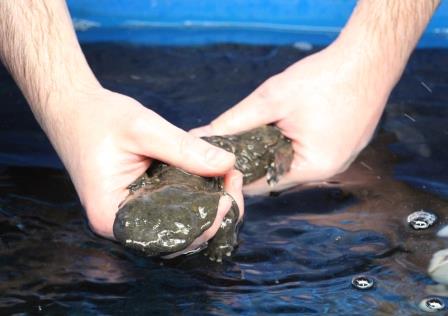
The Maryland Zoo also has five juvenile eastern hellbenders in a temporary holding tank which came from the Buffalo Zoo, another leading zoo in terms of hellbender conservation. Through the Buffalo Zoo’s head-start project, hellbender eggs are collected from the wild, hatched, raised to a size at which they are likely to survive predation, and re-released in the Allegheny River system.
So what do visitors to the The Maryland Zoo think of the eastern hellbender?
“The hellbender is a hidden gem,” says the Zoo’s Reptile/Amphibian Conservation and Collection Manager, Kevin Barrett. “It lives in Maryland, but I’d guess that ninety-nine percent of our visitors have never seen one until they come here.”
Given the realistic appearance and dark lighting of the exhibit, and the hellbender’s elusive nature and natural camouflage, a visitor’s first glimpse of the hidden gem can require a bit of patience. But it comes with a quite a payoff.
According to Kyle Baumgartner, Area Manager for the Maryland Wilderness section of the zoo, the “Where’s Waldo” thrill of finding something seemingly hidden, combined with the startling, prehistoric appearance of the eastern hellbender makes a lasting impression. “Kids are blown away by it,” he said.
“That moment is what I enjoy the most,” said Barrett, “When that little kid looks and looks for the animal, suddenly sees it, and says ‘Oh my gosh! That’s so cool!’”
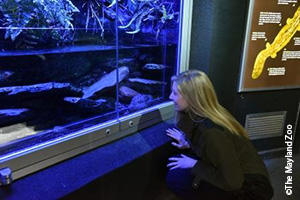
According to Baumgartner, giving people a chance to see a threatened or endangered creature that is native and local greatly facilitates a visitor’s jump from learning about a species to caring about its conservation.
“You can talk about elephant conservation all day long, and that is important, but elephants are thousands of miles away from here,” said Baumgartner. “The eastern hellbender is in Maryland’s backyard. If something is killing this animal in the stream you might be fishing or swimming in, what is that going to do to you? If agricultural runoff and other pollutants are causing them problems, what are they doing to us?”

Once that connection is made, said Baumgartner, visitors begin to understand that they can take small steps, such as stopping erosion in their neighborhood streams, which can have a positive impact downstream. But experts agree that for both the eastern hellbender and Japanese giant salamander, a great deal of habitat protection and improvement is needed.
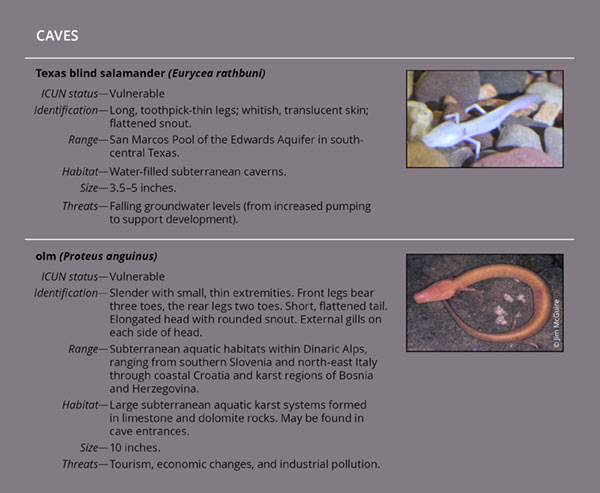
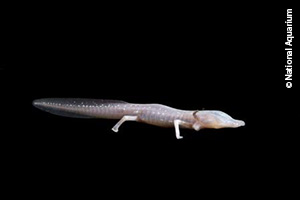
Imagine living in a dark cave, underwater, with only your non-visual senses to guide you toward food or shelter. Now you know what it’s like to be a Texas blind salamander (Eurycea rathbuni) or an olm (Proteus anguinus). Frail, slender, and virtually pigmentless, the Texas blind salamander lives in the underground water system of the limestone caverns of the Edwards Aquifer near San Marcos, Texas.
The olm, also slender, but two to three times the length of the Texas blind salamander, is found in underwater caves in Slovenia, Croatia, Bosnia and Herzegovina, and Italy.
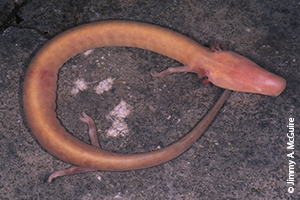
Though they belong to different families—the olm is a member of the Proteidae family and the Texas blind salamander is a member of the Plethodontidae (lungless salamander) family—they share many characteristics, including a strong dependence on the stability and purity of their subterranean habitats.
Both the Texas blind salamander and the olm are completely aquatic, and both have skin so translucent their internal organs are visible. Little is known about how either species breeds and reproduces. Both creatures live in total darkness, so they have no need for vision, and rely on their acute sensory systems to find food (mainly subterranean invertebrates). The Texas Blind salamander is thought to rely primarily on smell and vibration.
“With its little matchstick legs, and no pigment, it looks like this poor, skinny, little guy,” said Cover, who is able to observe the Texas blind salamanders currently on exhibit at the National Aquarium. “There’s not much food [in its habitat] but it eeks out a living. Once in a while, it’ll feed on some kind of aquatic arthropod that was nourished by bat guano.”

The olm actually uses chemoreceptors, mechanoreceptors, and electroreceptors. Both species live in a low-energy environment. Perhaps that is why the olm can survive without food for up to 10 years. The olm clearly is doing something right. It is thought to be the longest-lived amphibian, living an average of 69 years. According to studies conducted by the University of Lyon, olms also show no sign of age-related physical decline.
Despite its impressive lifespan, the olm, like the Texas blind salamander, is incredibly sensitive to environmental change. For the Texas blind salamander, whose habitat is located between the cities of Austin and San Antonio, threats are directly attributable to burgeoning development, which not only leads to pollution of runoff and groundwater, but reduces groundwater levels. Though the olm is considered a national treasure by the government of Slovenia, and even appears on one of its coins, and though much of its Slovenian range lies within proposed national or international protected areas, population declines are well documented, with tourism, economic changes, and industrial pollution all posing threats.
